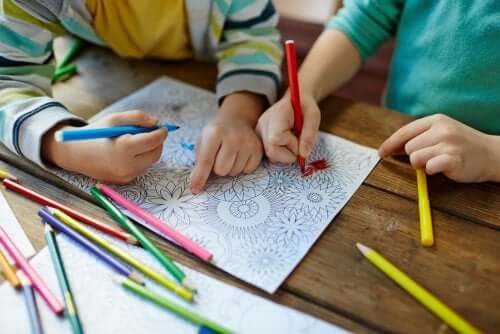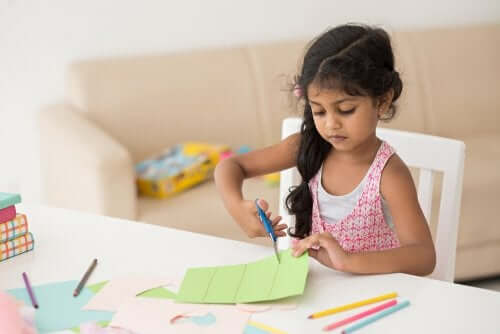6 Books to Stimulate Creativity in Children

If you want to help develop your children’s creativity, don’t hesitate to show them these books that stimulate creativity in children that we’ll share below. We’re sure they’ll have a lot of fun reading them!
Children’s creativity can be developed in several different ways, both at school and at home. Today, we’d like to focus on doing so through books and reading.
Books to stimulate creativity in children
1. Doodle-a-Day by Chris Riddell
As the title of the book indicates, the author invites readers to color in, doodle, write, and draw in this book every day.
In addition to allowing children to express their creativity, this book also includes tips for improving or examples to implement to develop this skill in a simpler way.
2. Mandalas para niños (In English: Mandalas for Children)
Nowadays, mandalas are one of the most-used tools for relaxation and to foster creativity in adults. But they’ve also been adapted to children, with easier but equally relaxing drawings for them.
Children really enjoy drawing and coloring, as it allows them to combine different colors. This is why they’ll definitely love this book!

3. Animals by Ingela P. Arrhenius, one of the books to stimulate creativity in children
This book will allow children to learn more about the main stars of this book, animals, through drawings, color combinations, and different typographies.
With this book and your help, children can create stories of each of the animals, thus developing their imagination and literary creativity.
4. Wreck This Journal: To Create is to Destroy, Now With Even More Ways to Wreck! by Keri Smith
This book is more geared for children age 10 and up and teens because, as its name suggests, the book is acquired to be wrecked.
A lot of people consider it a book to unleash creativity, as it offers readers the opportunity to engage in destructive acts, such as cutting pages, gluing a newspaper, painting with coffee, or poking holes through pages, among many other fun activities.
This is a witty and creative book that will allow children to experience and create at will. In addition, there’s the possibility of buying it with a briefcase that contains crayons and allows you to transport the book to any place so your child can be inspired anywhere they want.
5. Ingenios (In English: Ingenious) by Philippe Brasseur, one of the books to stimulate creativity in children
Anaya, one of the best-known children’s book publishers, published this book for children aged 10 and up. In it, you’ll find many different ideas to stimulate and develop creative thinking in children.
With famous people from history such as Einstein, Darwin, or Da Vinci, children can unleash their creativity with what Anaya states are the three basic principles of creativity:
- Being imaginative.
- Acting decisively.
- Stimulating curiosity.

6. Creativos y felices: entrena tu creatividad y tus emociones con las pequeñas mentes de colores (In English: Creative and happy: train your creativity and emotions with small colorful minds) by Clara Peñalver and Sara Sánchez
In this book, in addition to stimulating working creativity, you can broaden the subject of emotional intelligence with your children. The four small colorful minds are the four main characters of the book, and each color has a different meaning.
- The color blue develops creativity through puzzles.
- Secondly, the color red develops intelligence through challenges that the children will have to solve mentally.
- The color yellow is suitable for the minds that wander the most and are more fun.
- Finally, the color green is for feelings.
In short, it’s a book in which you’ll find puzzles, games, and many other activities to develop both emotions and creativity.
If you want to help develop your children’s creativity, don’t hesitate to show them these books that stimulate creativity in children that we’ll share below. We’re sure they’ll have a lot of fun reading them!
Children’s creativity can be developed in several different ways, both at school and at home. Today, we’d like to focus on doing so through books and reading.
Books to stimulate creativity in children
1. Doodle-a-Day by Chris Riddell
As the title of the book indicates, the author invites readers to color in, doodle, write, and draw in this book every day.
In addition to allowing children to express their creativity, this book also includes tips for improving or examples to implement to develop this skill in a simpler way.
2. Mandalas para niños (In English: Mandalas for Children)
Nowadays, mandalas are one of the most-used tools for relaxation and to foster creativity in adults. But they’ve also been adapted to children, with easier but equally relaxing drawings for them.
Children really enjoy drawing and coloring, as it allows them to combine different colors. This is why they’ll definitely love this book!

3. Animals by Ingela P. Arrhenius, one of the books to stimulate creativity in children
This book will allow children to learn more about the main stars of this book, animals, through drawings, color combinations, and different typographies.
With this book and your help, children can create stories of each of the animals, thus developing their imagination and literary creativity.
4. Wreck This Journal: To Create is to Destroy, Now With Even More Ways to Wreck! by Keri Smith
This book is more geared for children age 10 and up and teens because, as its name suggests, the book is acquired to be wrecked.
A lot of people consider it a book to unleash creativity, as it offers readers the opportunity to engage in destructive acts, such as cutting pages, gluing a newspaper, painting with coffee, or poking holes through pages, among many other fun activities.
This is a witty and creative book that will allow children to experience and create at will. In addition, there’s the possibility of buying it with a briefcase that contains crayons and allows you to transport the book to any place so your child can be inspired anywhere they want.
5. Ingenios (In English: Ingenious) by Philippe Brasseur, one of the books to stimulate creativity in children
Anaya, one of the best-known children’s book publishers, published this book for children aged 10 and up. In it, you’ll find many different ideas to stimulate and develop creative thinking in children.
With famous people from history such as Einstein, Darwin, or Da Vinci, children can unleash their creativity with what Anaya states are the three basic principles of creativity:
- Being imaginative.
- Acting decisively.
- Stimulating curiosity.

6. Creativos y felices: entrena tu creatividad y tus emociones con las pequeñas mentes de colores (In English: Creative and happy: train your creativity and emotions with small colorful minds) by Clara Peñalver and Sara Sánchez
In this book, in addition to stimulating working creativity, you can broaden the subject of emotional intelligence with your children. The four small colorful minds are the four main characters of the book, and each color has a different meaning.
- The color blue develops creativity through puzzles.
- Secondly, the color red develops intelligence through challenges that the children will have to solve mentally.
- The color yellow is suitable for the minds that wander the most and are more fun.
- Finally, the color green is for feelings.
In short, it’s a book in which you’ll find puzzles, games, and many other activities to develop both emotions and creativity.
All cited sources were thoroughly reviewed by our team to ensure their quality, reliability, currency, and validity. The bibliography of this article was considered reliable and of academic or scientific accuracy.
- Lowenfeld, V. (1987). Desarrollo de la capacidad creadora. Ed. Kapelusz. Argentina: Buenos aires.
- Madi, I. (2012). La creatividad y el Niño. Palibrio. Estados Unidos.
- Vargas, R. R. (2001). Niños creativos.
- Wallon, P., Cambier, A. y Engelhart, D. (1992). El dibujo del niño. Siglo XXI editores. España: Madrid.
This text is provided for informational purposes only and does not replace consultation with a professional. If in doubt, consult your specialist.








